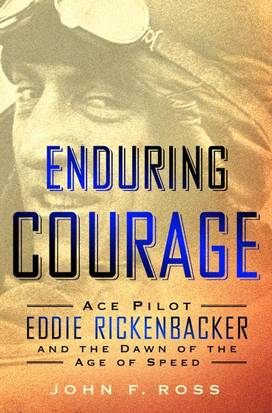Author Tells How WWI Flying Ace Showed ‘Enduring Courage’

September 9, 2014
WASHINGTON — In “Enduring Courage” John F. Ross aims to revive the memory of World War I flying ace Eddie Rickenbacker, who was also an early racecar driver of renown, and the creator of now-defunct Eastern Air Lines.
“I spent a lot of time reading about Eddie Rickenbacker, his buddies, the kids, the flyboys,” said Ross at a book gathering, “and the early American air service over northern France flying against the real pros, the Germans, the Flying Circus. You read their journals and their letters home, they’re talking these life-and-death things.”
Rickenbacker was born in 1890 in Columbus, Ohio, the oldest son of two poor Swiss immigrants. His mother was the strongest influence on Rickenbacker.
“Eddie grew up watching his fiercely self-reliant mother doing whatever it was to survive,” says Ross in the book. Rickenbacker was no slouch on his own, selling newspapers as a 5-year-old and keeping goats to sell their milk. After his abusive father died in 1904, he lied about his age and got a job at a glass factory.
Ross devotes most of “Enduring Courage’ to two sections of Rickenbacker’s life: the automobile and the airplane.
In the early 20th century, “there was this incredible intersection in American history between the car … and the airplane,” Ross said. He discovered something he never knew: “Eddie Rickenbacker was a race-car driver.”
Rickenbacker’s love of the automobile started in his early teens when he got a job with one of the small garages in Columbus, learning about all the vehicles of the early automotive industry.
This led to racing cars during a very dangerous time. The auto industry was in its infancy and racecars weren’t made for safety. The drivers were often casualties in the pre-seatbelt, pre-windshield era. “In cars they went from these amateurs to this new breed of professionals,” said Ross.
Rickenbacker was a top racecar driver before turning his abilities a different way: flying.
In the early 1900s, airplanes had evolved quickly from the cloth-and-bailing wire of the Wright Brothers to the warplanes of the Western Front of World War I with their open cockpits and lack of parachutes. It was also mostly for the upper crust and Rickenbacker faced discrimination from his immigrant background. That didn’t matter in the long run; flyers died on a daily basis in dogfights between the Allies and Germany’s flashy-painted squadron, the “Flying Circus,” led by Baron Manfred von Richthofen.
“Pilots were largely on their own, picking up insights from fellow fliers and always, if they wished to live, paying attention,” writes Ross.
Rickenbacker would become the American to ace with 26 kills to his name.
After the war, he went into business, succeeding and failing, but finally building Eastern Air Lines.
He still ran into risks. During World War II, on a trip to Asia, he was on a B-17 that crashed into the Pacific Ocean. It took them over three weeks to be rescued, and many of the survivors credited Rickenbacker for keeping them alive.
He died at 82.
“I think writing a book is, at its best, a kind of a voyage of exploration,” Ross said. “You’re surprised and baffled and challenged.”
“This book is about courage. This book is about new things, new technologies, adopting and what it was like to take them to their end. This was the first ‘Right Stuff.’”
———
“Enduring Courage: Ace Pilot Eddie Rickenbacker and the Dawn of the Age of Speed” by John F. Ross; St. Martin’s Press, NY (400 pages, $26.99)
———
©2014 McClatchy Washington Bureau
Visit the McClatchy Washington Bureau at www.mcclatchydc.com
Distributed by MCT Information Services















